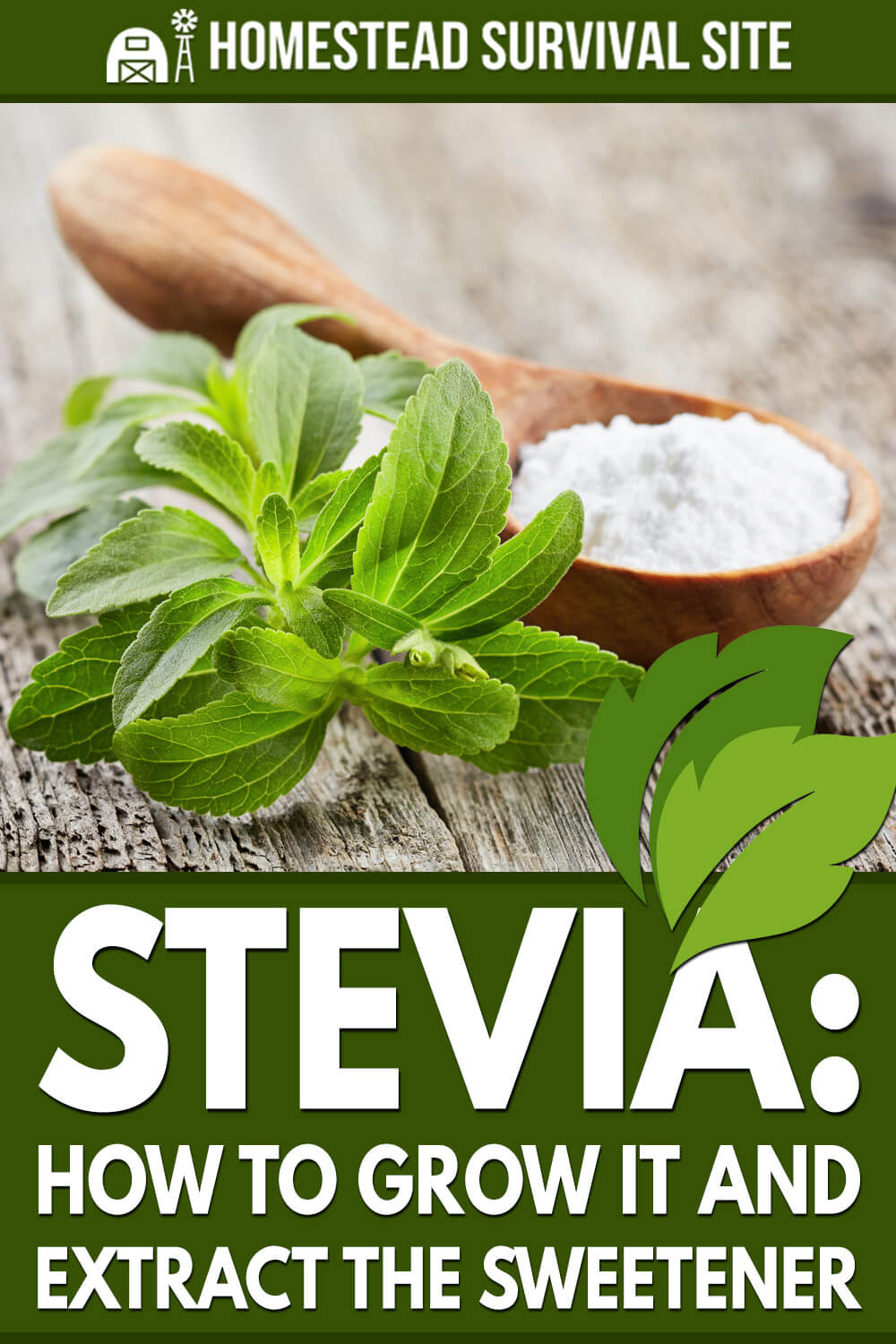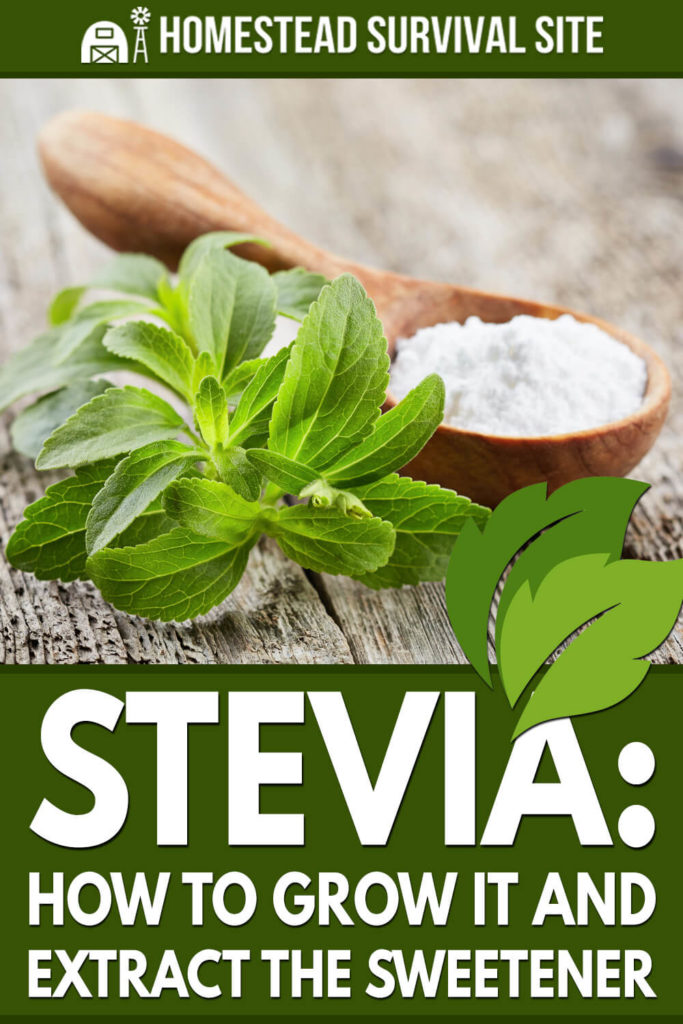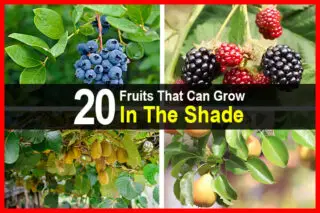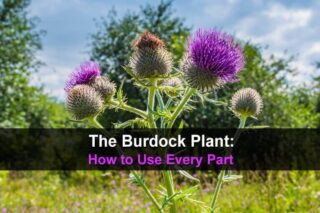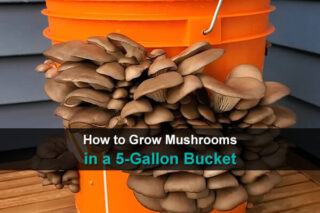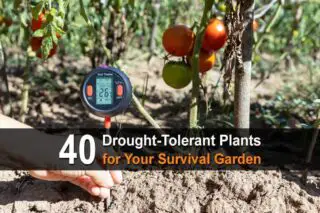Estimated reading time: 8 minutes
In our sweetened world, it seems that almost every processed food has a surprising amount of sugar. Homesteaders, diabetics, and organic enthusiasts alike have looked to other plants to provide a sweet taste without the added sugar intake.
While there are several sugar alternatives on the market, stevia is a natural option that has popped up in both community gardens and homesteads alike. It is well known for its ultra-sweet taste at 250-300 times sweeter than table sugar without the added calories.
Learn more about how to grow stevia and extract the sweetener all on your own.
Want to save this post for later? Click Here to Pin It On Pinterest!
What Is Stevia?
Formally identified as stevia rebaudiana, the stevia plant is easy to miss if you don't know what to look for. It is a perennial plant that is original to Brazil and Paraguay.
The stevia plant is a dull green color and usually is about 1-3 feet tall. The leaves are oblong and about an inch in length with a prominent midrib and scalloped edges. Some more mature stevia plants will produce small white flowers consisting of 5 petals. However, the flowers are usually removed to enhance the flavor of the leaves.
Stevia is a shrub that is part of the sunflower family. There are over 150 species of stevia and the plant includes 8 glycosides, which are the sweet parts of the leaves. These glycosides include:
- Dulcoside A
- Rebaudioside A
- Rebaudioside C
- Rebaudioside D
- Rebaudioside E
- Rebaudioside F
- Steviolbioside
- Stevioside
Stevia is known as a non-nutritive sweetener that means that it has little to no calories. This is the key part of the stevia market as the taste is sweet without the spike in blood sugar or added calories of sugar. Many homesteaders also prefer stevia because it is a natural plant as compared to other alternative sweeteners.
History of Stevia Use
Stevia has been used in its natural form for thousands of years by indigenous people in its native habitat. However, you may have heard that stevia was once banned from the US markets.
Stevia was banned by the FDA in 1991 when many consumers ate other sugar substitutes like aspartame. A few studies done on the plant showed concerning results when given in highly concentrated amounts to lab animals.
In 2008, stevia was allowed to enter the consumer market in certain forms as a GRAS, or generally recognized as a safe sugar substitute. However, there are still many side effects associated with the consumption of stevia. It is recommended to use stevia in small amounts, which is ideal given its incredible sweetness.
The commercial stevia options may include extra additives and chemicals. Your best bet for natural stevia is to grow your own plant and harvest the stevia yourself.
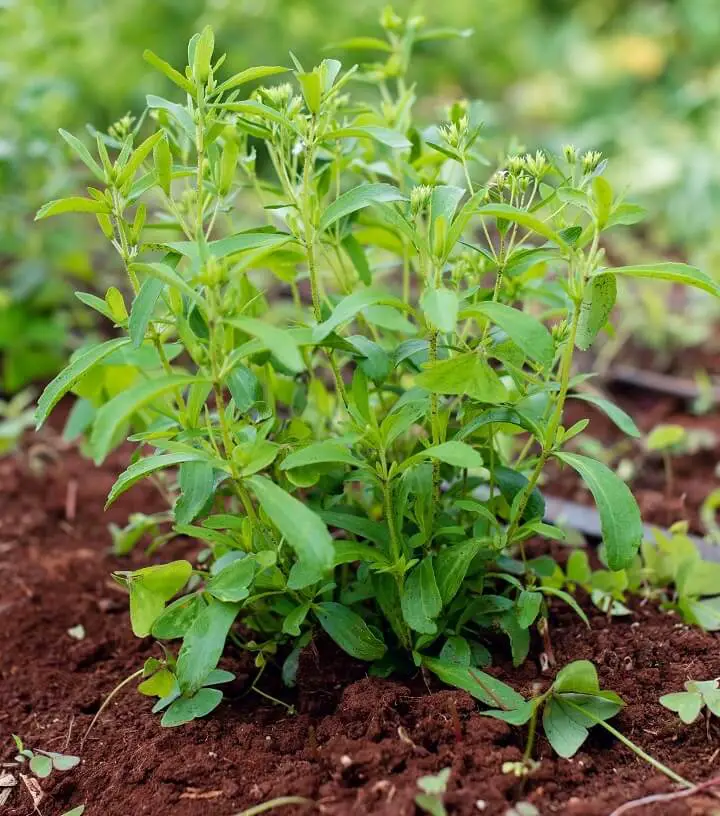
Special Diets
Diabetics with high blood sugar often use sugar substitutes to keep their blood sugar levels under control. Stevia has entered this consumer space as a sugar alternative and as a no-calorie sweetener. Adding stevia to food as a sugar substitute helps diabetics and others wanting to reduce calorie intake in an effort to lose weight or become healthier.
How to Grow Stevia
Learning to grow this natural sugar alternative in your garden is a great option for homesteaders all over the nation.
Best Soil Conditions
Stevia is a perennial plant that loves the sun. It is hard to grow from seed, so most homesteaders grow it from cuttings or young plants found at your local garden center.
Plant stevia in a warm spot of the garden or in a container at least 18 inches apart from other plants. It does best in well-drained soil with a 6.7-7.2 pH. You'll need to feed and water the plant on a regular basis to promote leaf growth.
Recommended Growing Zones
Stevia is safe to grow in USDA zones 8 or higher, which means that colder homesteads should grow it in a greenhouse or under a protective covering. Stevia plants can survive some winter seasons, but the leaves of mature plants aren't as desirable. Most homesteaders choose to grow new plants each year for the tender leaves.
Prune back the stevia plant a few times to prevent the white flowers from growing. This will help the leaves branch out, giving you a larger plant to work with.
How to Harvest Stevia
The stevia plant is much like the basil plant in that it will become bushier and fuller if you pinch the plant back. Harvest the leaves by removing them from the stem.
Decide whether you'll be drying the leaves or extracting the liquid from them. You can add fresh leaves directly to beverages, although the leaves are less concentrated in the whole form.
How to Dry Stevia Leaves
Some homesteaders choose to dry their stevia leaves, which is the easiest way to make sweet-tasting crumbles or powder. Simply tie up the stems to create bundles of leaves and hang them upside down in a cool and dark place.
You can also process the stevia leaves in a food dehydrator or on a drying rack. Once all of the moisture is gone, remove the leaves and store them in an airtight container like a mason jar.
How To Make Stevia Powder
To make a powder, simply remove the dry leaves and grind them up in a food processor or blender to create a smooth powder. You could also use a mortar and pestle.
Add the stevia powder to dishes and baking recipes as a delicious sugar substitute. Note that stevia powder doesn't dissolve into liquid, so it is best when mixed into a recipe to be evenly distributed.
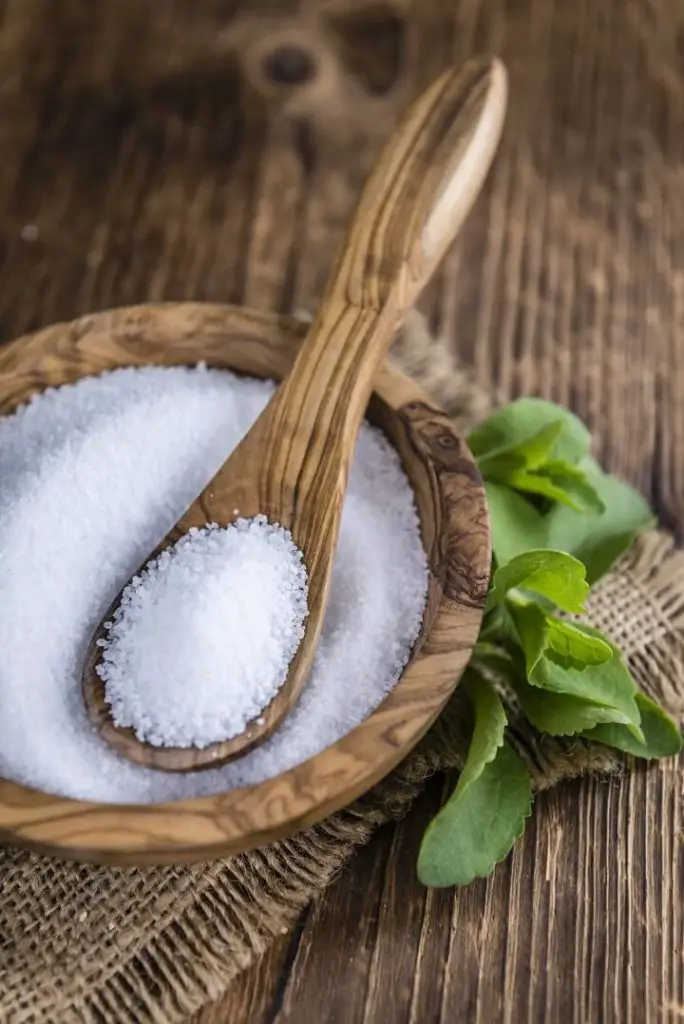
How to Use Stevia Powder in Recipes
When making your own stevia powder, you may need to do some taste testing to get the desired level of sweetness in your recipes. Due to stevia's extra sweet taste, you only need to use about ⅛ teaspoon of powder to equal the sweetness of 1 teaspoon of sugar.
You may notice that homemade stevia powder is green in color rather than the white color seen in store-bought varieties. Do your own taste test to find how much natural stevia powder to use for the desired sweetness.
Stevia powder doesn't dissolve like sugar, so consider making the extract to add to liquids or drinks. The powder also doesn't caramelize like sugar over high heat and may not do well when used for yeast breads. Check out online stevia recipes for the perfect blend of sweetness!
How To Make Stevia Extract
Making stevia extract from your stevia plant can save you a lot of money as opposed to buying it in the store. Making your own stevia extract also allows you to control how it is processed and ensure that there are no added flavors or additives.
Making your own stevia extract is much like making a tincture. Here are the instructions:
Step 1 – Begin by taking the stevia leaves and chop them up finely with a sharp knife.
Step 2 – Put the chopped leaves in a mason jar and pour vodka over them to coat the leaves.
Step 3 – Put the lid on the jar, shake, and let it rest on the counter for 24-36 hours. If left longer to steep, the sugar content and flavor of the extract will dramatically lessen.
Step 4 – Filter out the leaves and remove the alcohol from the jar by gently heating the liquid over low heat for about 20 minutes, making sure that the liquid never boils. The liquid will begin to thicken when exposed to longer amounts of heat on the stove.
Store cooled stevia extract in a colored small bottle that will protect it from sunlight. Many homesteaders use a glass medicine bottle with a dropper to make it easy to add the stevia extract to recipes.
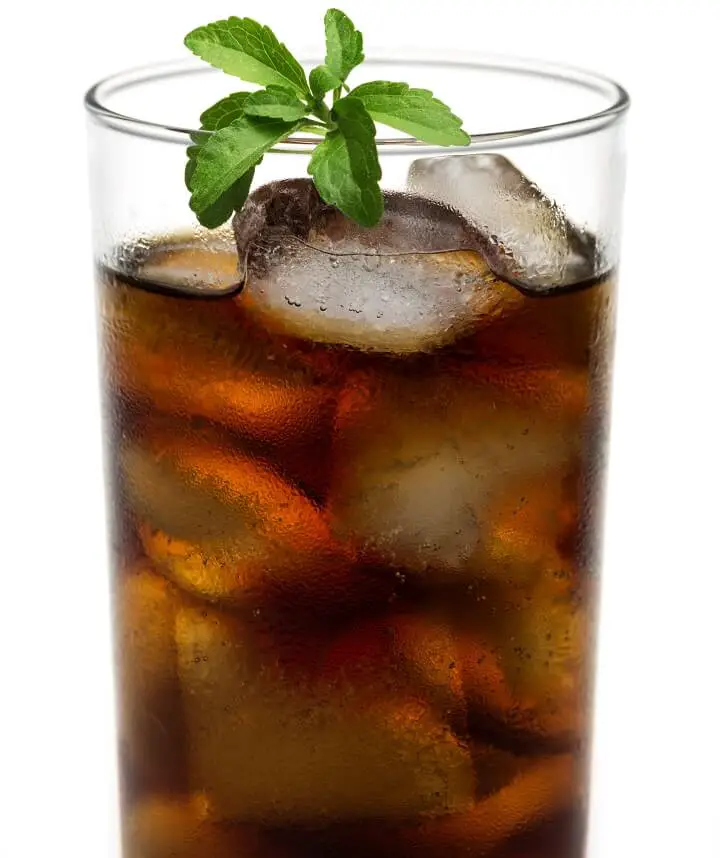
How to Use Stevia Extract In Recipes
Remember that stevia is a highly concentrated sweetener, so a little really does go a long way! Storing stevia extract in a small bottle with a medicine dropper is ideal. Simply add 1-2 drops of the extract into beverages for a sweet taste.
Note that homemade stevia extract may taste different than store-bought extract. It all depends on the amount of leaves used and if there are any added ingredients from the store-bought versions. There are some online stevia calculators that can help you find the right amount of stevia to add to a recipe.
However, note that your homegrown stevia may be less or more sweet than store-bought versions. It is always best to try different amounts of homegrown stevia and create your own conversion chart with each batch.
Growing your own stevia plant on the homestead is the best way to ensure that your stevia is as natural as possible. It is easy to grow the plants in warm conditions and you can choose to use the leaves in both powder or liquid form.
Adding natural stevia to your drinks or food is a great way to have a sweet taste without the added calories. Consider adding it to your garden this year for a natural alternative to table sugar.
Like this post? Don't Forget to Pin It On Pinterest!

